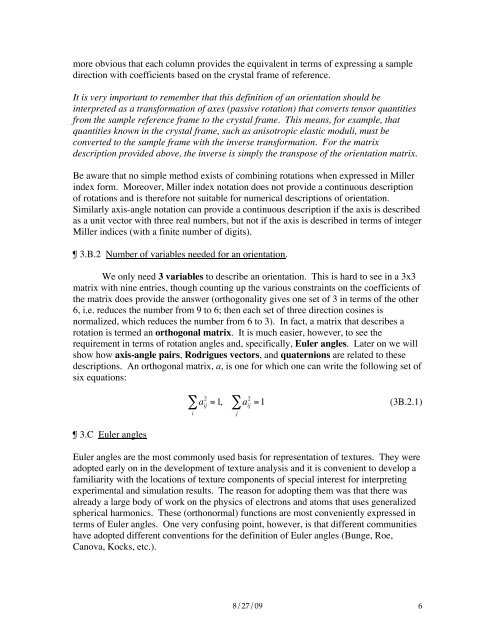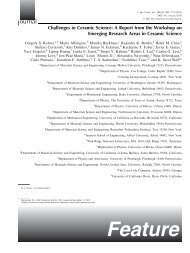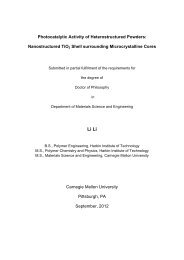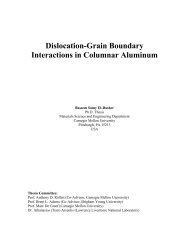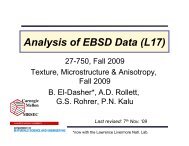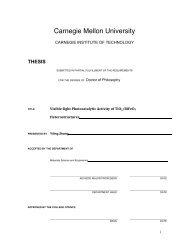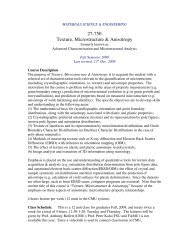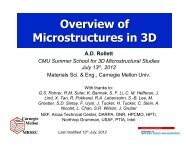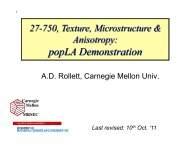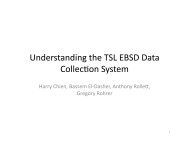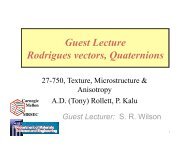¶ 3. Mathematical Representation of Crystal Orientation, Misorientation
¶ 3. Mathematical Representation of Crystal Orientation, Misorientation
¶ 3. Mathematical Representation of Crystal Orientation, Misorientation
You also want an ePaper? Increase the reach of your titles
YUMPU automatically turns print PDFs into web optimized ePapers that Google loves.
more obvious that each column provides the equivalent in terms <strong>of</strong> expressing a sample<br />
direction with coefficients based on the crystal frame <strong>of</strong> reference.<br />
It is very important to remember that this definition <strong>of</strong> an orientation should be<br />
interpreted as a transformation <strong>of</strong> axes (passive rotation) that converts tensor quantities<br />
from the sample reference frame to the crystal frame. This means, for example, that<br />
quantities known in the crystal frame, such as anisotropic elastic moduli, must be<br />
converted to the sample frame with the inverse transformation. For the matrix<br />
description provided above, the inverse is simply the transpose <strong>of</strong> the orientation matrix.<br />
Be aware that no simple method exists <strong>of</strong> combining rotations when expressed in Miller<br />
index form. Moreover, Miller index notation does not provide a continuous description<br />
<strong>of</strong> rotations and is therefore not suitable for numerical descriptions <strong>of</strong> orientation.<br />
Similarly axis-angle notation can provide a continuous description if the axis is described<br />
as a unit vector with three real numbers, but not if the axis is described in terms <strong>of</strong> integer<br />
Miller indices (with a finite number <strong>of</strong> digits).<br />
<strong>3.</strong>B.2 Number <strong>of</strong> variables needed for an orientation.<br />
We only need 3 variables to describe an orientation. This is hard to see in a 3x3<br />
matrix with nine entries, though counting up the various constraints on the coefficients <strong>of</strong><br />
the matrix does provide the answer (orthogonality gives one set <strong>of</strong> 3 in terms <strong>of</strong> the other<br />
6, i.e. reduces the number from 9 to 6; then each set <strong>of</strong> three direction cosines is<br />
normalized, which reduces the number from 6 to 3). In fact, a matrix that describes a<br />
rotation is termed an orthogonal matrix. It is much easier, however, to see the<br />
requirement in terms <strong>of</strong> rotation angles and, specifically, Euler angles. Later on we will<br />
show how axis-angle pairs, Rodrigues vectors, and quaternions are related to these<br />
descriptions. An orthogonal matrix, a, is one for which one can write the following set <strong>of</strong><br />
six equations:<br />
<strong>3.</strong>C Euler angles<br />
2<br />
2 ∑ aij =1, aij i<br />
j<br />
∑ =1 (3B.2.1)<br />
Euler angles are the € most commonly used basis for representation <strong>of</strong> textures. They were<br />
adopted early on in the development <strong>of</strong> texture analysis and it is convenient to develop a<br />
familiarity with the locations <strong>of</strong> texture components <strong>of</strong> special interest for interpreting<br />
experimental and simulation results. The reason for adopting them was that there was<br />
already a large body <strong>of</strong> work on the physics <strong>of</strong> electrons and atoms that uses generalized<br />
spherical harmonics. These (orthonormal) functions are most conveniently expressed in<br />
terms <strong>of</strong> Euler angles. One very confusing point, however, is that different communities<br />
have adopted different conventions for the definition <strong>of</strong> Euler angles (Bunge, Roe,<br />
Canova, Kocks, etc.).<br />
8/27/09 6


